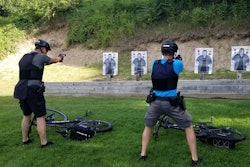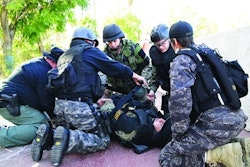 Is the 21-Foot Rule wrong?POLICE
Is the 21-Foot Rule wrong?POLICE
So says Jamie Borden, a retired sergeant with a large police department in Nevada and founder of Critical Incident Review (CIR)—a consultancy that helps line officers, police leaders, and civilian juries better understand how split-second decisions are made during rapidly unfolding, high-stress situations.
The so-called "21-Foot Rule" is something of an anecdotal outcome of an experiment conducted by Sergeant Dennis Tueller of the Salt Lake City Police Department in the early 1980s. Tueller wanted to know how quickly a subject armed with an edged weapon could cover in the time it takes for an average officer to unholster their sidearm and fire one round at the advancing threat.
Tueller found in his experiment that the average attacker could cover approximately 21 feet in the 1.5 or so seconds that it took an average officer with a holstered weapon to place shots on target. Tueller published his findings in the March 1983 issue of S.W.A.T. Magazine under the title "How Close is too Close?" and the rest, as they say, is history. The Tueller Drill was developed, the "Danger Zone" was determined, and the 21-Foot Rule became "a thing."
Unfortunately, in the time since Tueller conducted his experiment and wrote of his conclusions, this "rule" of 21 feet has at times become misappropriated by police critics and misused by police trainers.
Time and Distance
Borden says the 21-Foot Rule—as it has traditionally been discussed in police training and subsequently described in courtrooms—is both inaccurate and incomplete. In fact, he says the 21-Foot Rule was never intended to be a "rule" at all.
Borden says, "I think oftentimes the 21 foot—quote rule, end quote—gets misinterpreted. First of all, that it was an experiment… what it was designed to do was to show officers how quickly somebody could close the gap at 21 feet before an officer could draw their weapon."
Borden continues, "Everything takes time, right? It takes time to perceive [a threat]. It takes time to start to react to that threat, and then effectively respond to the threat. All of those components of time have to be considered. So training started to be developed around this '21 foot rule' and then it started to find its way into the courtroom."
Countless court cases—both criminal and civil—have brought expert witnesses to the stand to discuss the 21-Foot Rule.
A fashionably dressed attorney will saunter casually about as they rhetorically ask, "You're familiar with the 21-Foot Rule?"
"Yes," the witness will be forced to say—they are, after all, an expert.
"And you agree that this diagram of the incident shows that the victim was here," the solicitor will say as they point to an 'X' on a massive enlargement of a still image from a surveillance camera.
The witness chokes back any protest against using the word "victim" in place of "assailant" and agrees, "Yes, this is what the video shows."
"And this," the attorney says, "is where the officer was?"
A line on the image separating the two Xs is labeled, "31 feet."
The jury will watch this verbal jousting for a time as the lawyer eventually comes around to his or her assertion that their client was further than 21 feet from the officer when they fired their service weapon.
"Therefore," the lawyer says with something between a sneer and a smirk, "the officer acted outside of their training."
Everyone and anyone who has any real knowledge of the specific incident, that particular suspect, or even a rudimentary understanding of policing in general, then does a "face-palm."
"It's really important to understand that when we're talking about the distance and the component of human performance—when we're talking about the separation and distance from an officer and a suspect—what matters is that that suspect can close the gap very quickly, and that it's going to affect the officer's decision making process," Borden says.
Borden explains further that a key element to the entire discussion of the so-called 21-Foot Rule is the perceived intent of the subject and threat that the individual potentially poses.
A subject reported to be armed with a knife—and to have used that weapon in an assault that precipitated a call to police in the first place—may not upon visual inspection from seven yards away seem to have that blade in hand. But that person hasn't yet been searched. They may have the knife, plus another knife, plus a handgun.
Borden says that nothing can be taken at face value at this point.
"This certainly doesn't mean shoot first because 'you think!'," Borden says. "It means you always must be aware of the components of time, distance, speed, and motion while formulating a response or interpreting the scenario. When an officer has weapons in play—when an officer has responded based on the contextual cues of the call they're servicing, and they have to make decisions to protect themselves and protect the public—it may or may not have anything to do with an edged weapon. But that distance has got to be considered."
Borden continues, "A human being can close that [21-foot] gap faster than we can decide and respond," Borden says. "That has to be considered. It has to be considered in training. It has to be considered in our review and analysis of an incident across the board."
Borden concludes, "What I want people to understand is, take the 21-foot rule for what it is. It's understanding the dynamics of human movement—it's simply about how quickly someone can close the gap and how that movement and perceived intent is going to affect the officer's ability to make decisions effectively in those critical incidents."
Taken in Context
Ultimately, the 21-Foot Rule is now a genie that cannot be put back in the bottle.
It's been out there for nearly four decades and has become part of law enforcement culture and lore. Many studies have subsequently found that 21 feet is actually far less than what a person can cover in the time it takes for an officer to unholster their sidearm and shoot in self-defense—some of these studies say the distance is more like 31 feet.
Regardless of the distance, the critical piece is to take all contributing factors into consideration—there may be many.
What is the nature of the encounter? Is it self-initiated or a response to call for assistance?
What is known of the subject? Are they observed to be under the influence of drugs or alcohol? Are they emotionally disturbed?
What is known of the surrounding area? Are there other possible attackers nearby? Are there bystanders who may be caught in a crossfire?
What are the environmental conditions? Is it dark? Is it daytime? Is the ground surface stable or slippery?
Training officers in the so-called 21-Foot Rule can be useful, but it is incomplete if not also placed into the larger context of tactics available—and necessary—to address their real-time understanding of the totality of the circumstances of an incident as it is unfolding.
Read More: The Winning Edge: Improving Knife Defense Training
















